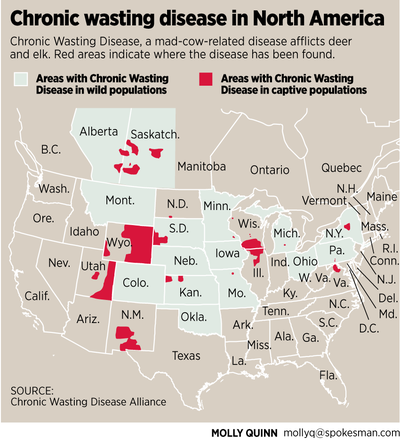CWD issues turn personal with news of diseased buck

I’ve been fortunate to hunt in North America for more than 30 years, mostly in Wisconsin but also in Alaska, Montana, Canada and Mexico, and have many treasured experiences.
The 2015 Wisconsin deer season, however, brought an unwelcome first in my world.
An 11-point buck I shot on Nov. 2 in Richland County, Wisconsin, tested positive for chronic wasting disease.
I learned about the test result last week.
The meat from this buck – which I deboned, wrapped and stored frozen – will be thrown in the garbage.
Destroying the venison goes against every grain of my hunting ethic. I wouldn’t kill an animal I didn’t intend to fully utilize.
The meat won’t be consumed in keeping with recommendations of the Wisconsin Division of Public Health, the Centers for Disease Control and Prevention and every other health agency to weigh in on the subject.
Since 2003, the Wisconsin Division of Public Health has recommended “venison from deer harvested inside the CWD Management Zone not be consumed or distributed to others until CWD test results on the sources deer are known to be negative.”
Although no human illness has been linked to CWD, health experts are clear and consistent in their recommendation: Don’t eat meat from a CWD-positive animal.
Chronic wasting disease is a transmissible spongiform encephalopathy, a family of diseases that includes mad cow, scrapie and Creutzfeldt-Jakob.
I’ve submitted eight deer for CWD testing since 2002, when the disease was first discovered in Wisconsin.
All of the animals looked healthy.
But the Richland County buck’s appearance concealed a deadly disease.
In its final hour, the buck was clearly the dominant deer in a field full of does and fawns.
It marched, nose down, searching for a receptive doe, before stopping 20 yards from my ground blind.
At the moment I took the shot, my intentions weren’t focused on disease control. They were on hunting and obtaining food.
I was fortunate to meet Beth Williams, the late wildlife researcher and acknowledged CWD expert from Wyoming, at a conference in 1995.
At the time, CWD wasn’t really a hot topic in Wisconsin.
Williams cautioned that it could become a very big deal in the future, even east of the Mississippi.
Twenty years later, CWD is found in a dozen states in the Midwest and eastern U.S.
And scientists have published evidence the disease has reduced mule deer herds in Colorado and is responsible for a decline in elk in Rocky Mountain National Park.
This is the herd- or population-level effect many fear will become apparent in coming years in Wisconsin.
Wisconsin officials initially attempted to eradicate the disease. Faced with mounting costs and push-back from some hunters and residents of the core disease area, the DNR backed away from its initial goal after several years.
Thirteen years later, the DNR merely does limited CWD surveillance in the state.
Moreover, rather than be forced to comply with new, stricter federal standards designed to reduce the spread of diseases, an emergency rule passed in December will allow Wisconsin deer farmers to simply opt out of the state’s chronic wasting disease monitoring program and not upgrade their fences.
The action was proposed by the Department of Natural Resources and approved by the Natural Resources Board.
These are contradictions to the state’s CWD management plan, which says the disease “has the potential for significant, negative impacts on the future of deer and deer hunting wherever it exists. Therefore, minimizing the area of the state where the disease occurs is the responsible goal to pursue.”
Wisconsin is taking no active measure to prevent the disease from spreading statewide.
The state enacted a statute in 2009 designed to prohibit deer carcasses from being moved from CWD-positive counties in Wisconsin into areas free of the disease.
The regulation is designed to prevent transfer of infectious prions, which are concentrated in the brain and other tissue.
Although hundreds, if not thousands, of violations of this deer carcass restriction are likely to occur each hunting season in Wisconsin, not a single citation has been issued, according to state records.
Wildlife managers and elected officials in Illinois, Michigan and Pennsylvania are taking a different path.
Illinois has continued to use sharpshooters since 2002 and kept the CWD prevalence rates close to 1 percent in the disease area.
Michigan is using sharpshooters and increased hunting pressure in an effort to snuff out the disease in the Lower Peninsula.
Last month, Michigan conservation wardens stopped five hunters from Illinois and Wisconsin and issued citations for bringing whole deer into the Wolverine State.
“To believe that we can’t control or eradicate this disease, is to ensure that we won’t,” said Wayne Laroche, director of the Pennsylvania Bureau of Wildlife Management, as he announced heightened testing for CWD. “We need to do everything we can to put out the fire before it spreads out of control across the state.”
It’s hard, expensive work to combat wildlife diseases.
The Wisconsin Department of Natural Resources now lists 38 of the state’s 72 counties as “CWD-affected.”
The CWD prevalence rate in adult bucks exceeds 40 percent in the core disease area of Iowa County.
In such areas, CWD-infected deer are likely to be around for the rest of our lives.
A logical step would be for the Legislature to pass a law banning deer baiting and feeding statewide. Those practices encourage deer to congregate, which increases disease transmission.
The DNR should also be charged with enacting a plan, based on the latest CWD science and management actions in other states, to help keep the disease from spreading further.
At some point, issues are no longer hypothetical. They get personal.
That happened for me when I received the news on my diseased buck.
Outdoors editor Rich Landers contributed to this story.